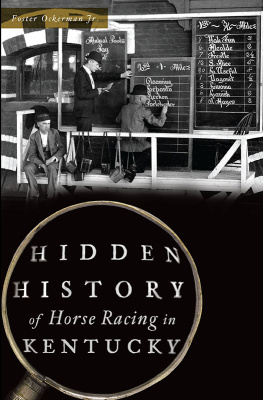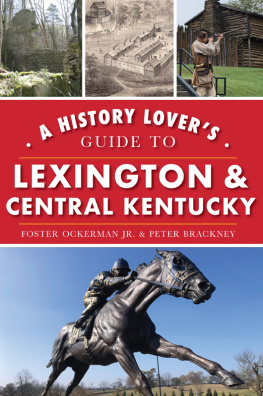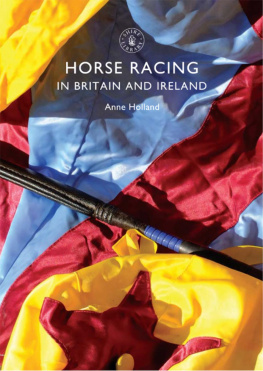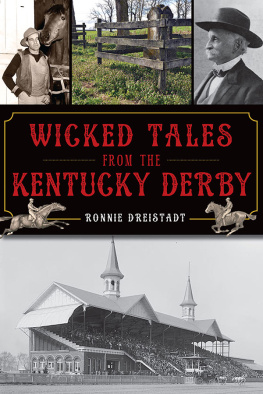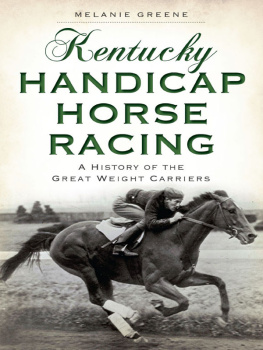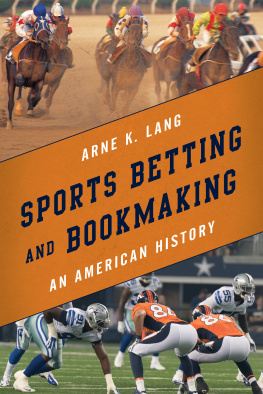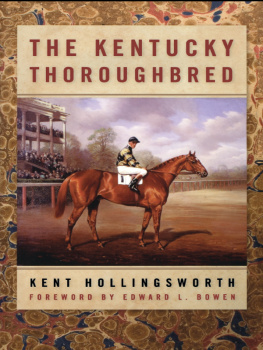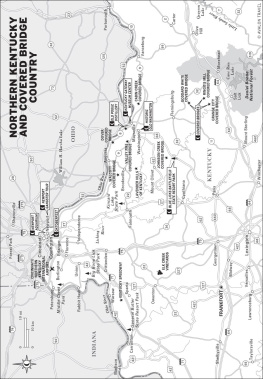

Published by The History Press
Charleston, SC
www.historypress.com
Copyright 2019 by Foster Ockerman Jr.
All rights reserved
Front cover: Keeneland Library.
inset: Bill Straus.
First published 2019
E-Book edition 2019
ISBN 978.1.43966.645.6
Library of Congress Control Number: 2018963657
Print edition ISBN 978.1.46713.894.9
Notice: The information in this book is true and complete to the best of our knowledge. It is offered without guarantee on the part of the author or The History Press. The author and The History Press disclaim all liability in connection with the use of this book.
All rights reserved. No part of this book may be reproduced or transmitted in any form whatsoever without prior written permission from the publisher except in the case of brief quotations embodied in critical articles and reviews.
This book is dedicated to our grandson, Michael Foster Helsby, in the hope that he comes to love history as much as his grandfather.
CONTENTS
ACKNOWLEDGEMENTS
This has been an intriguing detective hunt. My thanks go to Sarah Hubbard, director of the Kentucky Room and her staff at the Lexington Public Library; Becky Ryan, director of the library, and her staff at the Keeneland Association Librarya very beautiful place to conduct research; Eric Brooks, curator at Ashland, Henry Clays home; Chris Goodletter, curator at the Kentucky Derby Museum; local historian Bill Ambrose (especially for sharing some not-yet-published material); Patrick Lewis of the Kentucky Historical Society; Aaron Genton at Shaker Village of Pleasant Hill; the Adelin Wichman estate for permission to use her portraits of African American jockeys; and Andy Mead and Pace Emmons for taking photographs of the portraits at what proved to be difficult angles and the technical prowess to adjust for the angles; as well as Fran Taylor and Wendy Bright. I want to acknowledge the encouragement of the late Dr. Ken Kinghorn, professor of church history and a United Methodist historian, and his regular question: Well, what did you write this week? I also thank my wife, Martina, for allowing me to do a forced occupation of the dining-room table with books stacked all about while I was writing.
A portion of the sales proceeds of this book benefit the Lexington History Museum, Inc.
INTRODUCTION
According to the 2012 Kentucky Equine Survey, conducted by the University of Kentucky, the equine industry in Kentucky generated a total economic impact of almost $3 billion and created more than 40,000 jobs in the year prior to the survey. There were about 54,000 thoroughbred horses, 42,000 quarter horses, 36,000 Tennessee walking horses, 14,000 saddlebreds, 9,500 standardbreds and 12,500 Kentucky mountain horse breeds as well as ponies, draft horses, Arabians and other breeds. In the total were almost 4,000 breeding stallions. Lexington-Fayette County has the most horses, with some 89,000, followed by Bourbon, Woodford and Scott Counties, all in the central Bluegrass Region.
This book digs into history to find out how it all started. Here you will find that local racetracks once were almost as prevalent as high school football fields, that horse races were run on the main streets of early towns, that Henry Clay was as good a horse breeder as he was a politician and that African American jockeys were our countrys first professional athletes, among other tidbits of equine history.
THE HISTORY OF THE HORSE
Before there can be a history of horse racing, there must first be a horse to race. In Kentucky, at least, children were taught in elementary school that horses were first brought to the Americas by the Spanish conquistadors in the fifteenth century, and that escaped or abandoned horses went wild and spread into North America, where the native Indians adapted them to use.
While the latter part of that history is true, the Spanish did not first introduce horses here. In fact, the earliest animal that would evolve into the modern horse originated in North America.
The first little horse was Hyracotherium or Eohippus (dawn horse), which lived fifty-five to forty-five million years ago in central North America. It stood between ten and seventeen inches tall at the shoulder with four toes on its front legs and three toes on its hind legs. This configuration helped keep Eohippus from sinking into the swampy condition of the land at that time and evade predators.
Little Eohippus evolved into Mesohippus, now growing up to forty inches tall at the shoulder and possessing longer legs.
Next came Pliohippus or Equus, in the Pleistocene epoch; it would be recognized today as a horse.
For reasons not yet known, Equus became extinct in the Americas between eight thousand and ten thousand years ago.
Equus evolved into the modern horse in Central Asia. There, horses changed in use from sources of food to transportation, both pulling loads and as personal conveyance.
Finally, the horse came full circle and was returned to the Americas with Hernn Cortz on his excursion to Mexico in 1519.
Whether the first horse race started with a wager, a challenge or an inspired flight from danger is lost in the mists of history. Horse racing is one of the oldest sports, and its core concept has never changed: the horse that gets to the finish first wins!
What is clear is that once the basic tenets of how to break, train and ride a horse were worked out, military leaders were quick to take advantage of the escalation in weapons delivery the horse produced. The Assyrians, Egyptians, Mongols and other ancient peoples used chariots in battle. Chariot races were run in the Greek Olympics in 610 BC and are featured in Homers Illiad.
The Romans, of course, followed, and many nobles had large stables of horses.
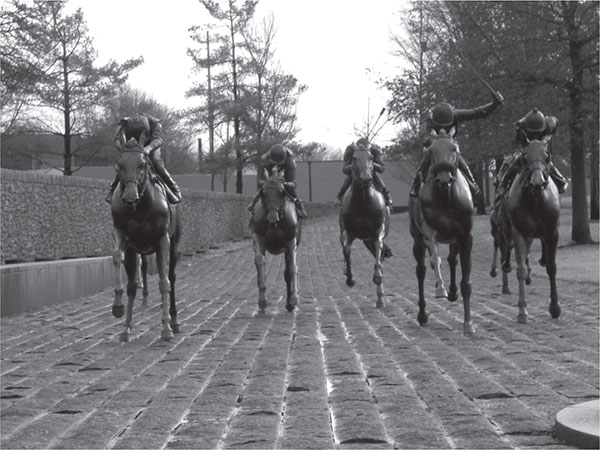
Thoroughbred Park. downtown Lexington, Kentucky. Photograph by author.
Owning, training and racing horses, and training riders beyond military and farm use began when English knights returned from the Crusades with fast Arab horses in the twelfth century.
The return of the Stuarts to the throne in 1660 with Charles II marked what is generally considered the beginnings of the modern era of horse racing. He was the first king to race horses under his own name.
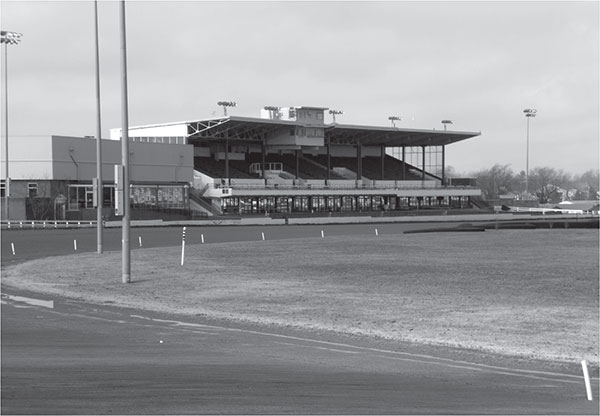
Red Mile Racecourse. Photograph by author.
In contrast to the long English history of thoroughbred racing, trotting or harness racing is said to have originated in North America. The New York Times in an 1897 article attributed it to early Dutch settlers. Anyone with a two-wheeled cart and a horse could race. By 1879, the term standardbred
RACING IN EARLY AMERICA
One observer commented that gambling is as American as apple pie and older than the Mayflower. Certainly that applied to horse racing.
Just four years after Charles II ascended to the throne, the commander of the British troops occupying New Amsterdam (present-day New York City) laid out a two-mile racetrack on Long Island called Newmarket, after the famous track in England. Colonel Richard Nicolls oversaw organized racing and offered a silver cup to the winner.
Next page
